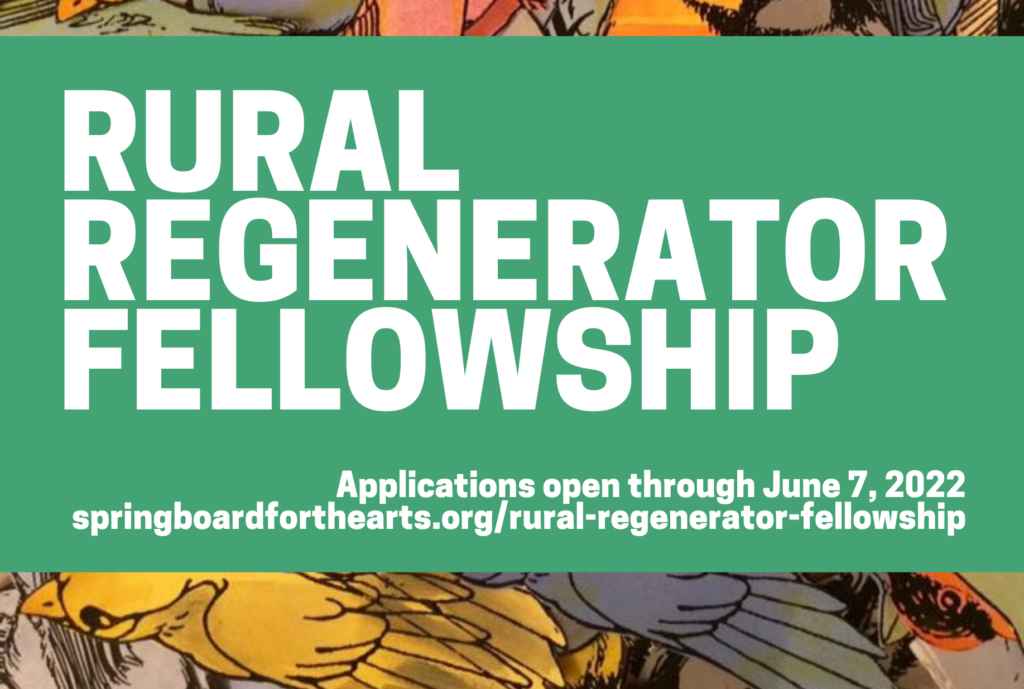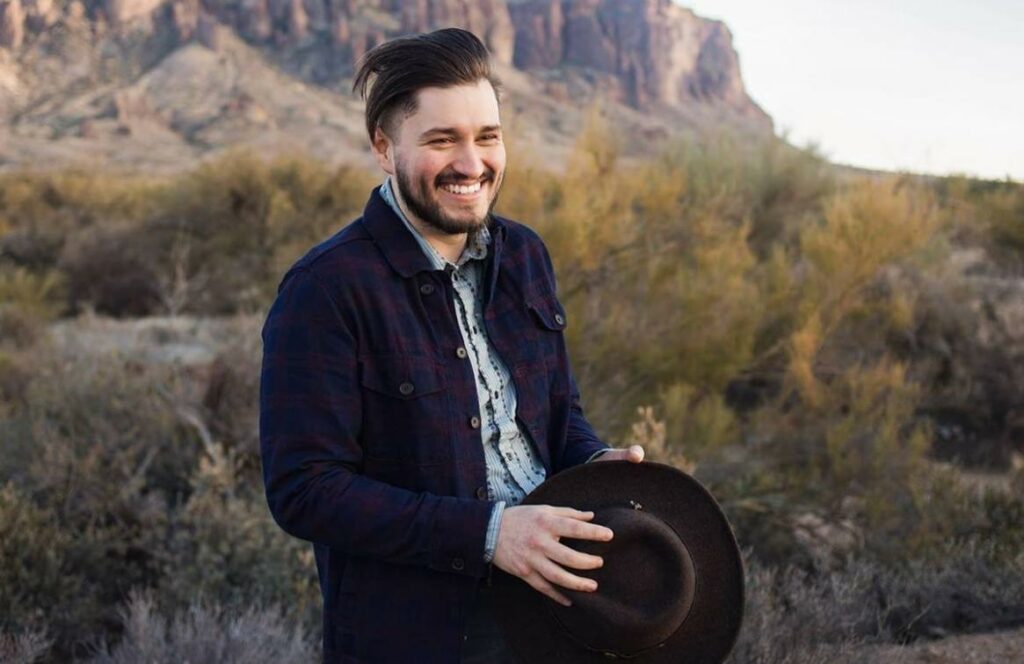Elisha Marin: Making Place, Fostering Connection
The Rural Regenerator Fellowship brings together individual artists, makers, and culture bearers, grassroots organizers, community development workers, public sector workers and other rural change-makers who are committed to advancing the role of art, culture and creativity in rural development and community building. In 2022, we asked a collective of local writers to sit down with current Rural Regenerator cohort members to share more about their work.
I can see a light in our future and it’s shining out
Everybody loving their neighbor, no more gunning people down
Can you hear the winds of change blowing?
What a glorious sound.
Elisha Marin’s voice is clear and soulful as he sings lyrics from the title track of his 2021 debut album, Shining Out. Written in response to the 2015 massacre at Mother Emanuel African Methodist Episcopal Church in Charleston, SC, this song is just one among several on the album that sends a message of unity and hope for the future. One only needs to be in Marin’s presence for a few moments to learn that this is his way in the world. He is a compassionate citizen whose mission is to “uplift the fellow human.” And so, he does.
A self-taught musician, graphic designer, placemaker, and seasoned educator, Marin’s talents often mingle to envision and create platforms for other artists to practice their craft. He says his efforts most often go toward helping “people who typically struggle to get connected with resources and exhibition opportunities.” Among those are women, minorities, and those who identify as emerging artists.
Growing up Latino in a small conservative community in Minnesota, Marin knows what it is like to have to advocate for yourself and your art when your work may seem counter to local culture. He understands the challenges of making art in rural communities that are not as visible and well-resourced as their metropolitan neighbors. He also knows the importance of having access to fellow makers with whom to network and collaborate, and resources to make new work. Of his own experience in pursuit of these necessities he says, “without art, artistic expression and the family that I’ve made in the arts, I genuinely wouldn’t be here today.” Marin’s resolve to declare himself an artist and dedicate his life to work both on stage and off, speaks to a philosophy of renewal and sustainability that is more than an idea; it’s an expression in brick and mortar.
One of the most exciting aspects of Marin’s work are his initiatives to restore endangered historical buildings and convert them into places for art and community. The Historic Bessesen Building in Albert Lea, Minnesota, was set to be demolished before Marin and his team took it over to create the Freeborn County Arts Initiative in 2012. Originally built in 1916 as an opera house by William Bessesen for the love of his life, opera singer Beatrice Gjertsen Bessesen, Marin works to keep this foundation of love a tangible undercurrent in all of the programming there. He is wistful as he describes that intention. “You see the efforts that people have gone through to create this. It’s impossible not to fall in love with [the story]. I want to pass that on in a very physical way.”
As part of the spirit of welcome and access infused throughout the space, all events and exhibitions are free to the public. Marin says that people come from a hundred miles away to participate in their events and support the initiative, which is a non-profit. Most recently, the Freeborn County Arts Initiative started a podcast celebrating artists from a variety of disciplines called, ARTWATCH. So far, the podcast has featured makers like sumi-e brush painter Dee Teller, textile artist Kathy Weed, and photographer Olivia Blinn. After years of volunteer work by himself and many members of the community, Marin is excited to share that the Initiative has just hired its first paid staff member.
Just over the border in Mason City, IA, Marin and collaborator Susanne Crane are working to restore another historic landmark. The YWCA at 2 Adams Avenue was built in 1918 by a group of suffragists. The building and organization predated the construction of a YMCA in that area, which was unusual for the time. Women across America were fighting for the vote and other basic civil rights when the Adams Avenue YWCA was erected. The history of Mason City tells us that women of that community used their collective voice to make the YWCA a reality. For the collaborators, this is inspiring and a powerful motivator in their work.
“Mason City has this really cool history of women in power making things happen,” said Marin in a 2021 article about the project’s inception. Crane and Marin look forward to creating artist apartments, studios, an art gallery, and performance space inside the building. For the moment, most of the work on the space has been dedicated to necessary renovations that will allow the creative work to begin in earnest. Still, Marin is excited for what the space will provide for the community and its artists when the time is right. “Wherever projects like this go, they start a renaissance. Providing housing stability for artists is really important. If you have housing and if you have collaboration accessible, wonderful things can happen.”
When asked about how his work aligns with the concept of rural regeneration, he muses, “in the same way that I work on literally fixing a historic building, you improve the things that need to be improved, and you preserve the things that if you don’t, could be lost to history. You cherish those things you love and the things that need addressing become priority.” He credits that viewpoint to his familial experience of migration and cultural erasure.
With family from Northern Mexico who migrated to Arizona and California, Marin says, “it’s very easy for your culture and your family history in particular to get lost in the shuffle” of assimilation. The same is true for physical spaces. Marin mentions how the decline of rural America over the last several decades is visible and that people often overlook the unique attributes of living in a small town, like the opportunity to know members of one’s community well, and the flexibility to pivot quickly in arts organizations with a small, dedicated teams of collaborators. He says people also overlook the significance of architecture, and the vibrant histories and traditions found in these places. The danger of losing any and all of these things is a driving force in Marin’s commitment to his communities and their cultural artifacts.
Though at times, it might be hard for an outsider to see the threads of connection between his varied interests and activities, Marin is clear about how each facet of his work feeds the others.
“My life is quite literally translated into song. When I approached the production of [Shining Out] I brought in my graphic design, which has a lot of historical type setting…physical characteristics that are turned into digital and printed again, so they come full circle.” Marin creates his own websites and print materials for all of his projects. He continues, “there’s so much spiritual, psychological, and emotional [labor] that goes into building places. And if I have one life to give, I can get up on stage and sing, that’s a beautiful moment that we can keep in our hearts and minds, but, if I put a hammer to a wall and create a space that people enjoy, that is an action that gets to last a lot longer.”
Elisha Marin is anticipating more exciting work on the horizon. A new album is in the works in addition to the gradual opening of the Mason City YWCA space to the public and a handful of resident artists. He also looks forward to the collaborations that will be made possible through the Rural Regenerator Fellowship’s networking opportunities and the visibility the program will give his work. After all, what is art, without someone to share it with? Marin concludes, “my passion is really bridging gaps, [and] connecting people together. I really do believe, and I think it’s pretty evident over the course of human history, that we are stronger together.



